Castles in Switzerland – Experiencing a Childhood Dream |
 |
| BERN: Bern Cathedral, Switzerland, in November 1978 |
|
|
 |
| The Cathedral of Bern in sunlight ca. 1984. Bern, the Swiss federal capital and capital of the Canton of Bern, was founded in the 12th C. on the River Aare in northwest central Switzerland. Bern is a city of ornate fountains and clock towers, museums, impressive government buildings, and beautiful villas. When the culture has been thoroughly enjoyed, there are wonderful restaurants and shopping: art, antiques, jewelry, designer fashions, china and crystal, textiles – something for every greedy little heart! |
|
|
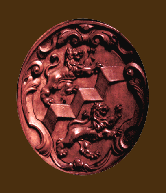 |
| Coat-of-Arms of the Noble Family of Diesbach at the Cathedral of Bern |
|
| On May 26, 1600, Abraham v. Graffenried [1580 – 1620], son of Anton v. Graffenried [1545–1612], m. Ursula v. Diesbach, daughter of Hans Rudolf v. Diesbach, the last Lord of Worb to belong to the distinguished Diesbach dynasty, which was elevated to nobility by the German Kaiser in 1434. Hans Rudolf died without male descendants in 1607. Ursula inherited a quarter of the estate, upon which Abraham became joint Lord of Worb. Abraham fell at the Battle of Tirano in the Veltlin in 1620. Through inheritances, gifts, and purchases, Abraham's son Christopher v. Graffenried [1603-1687] came into possession of the entire estate of Worb in 1668. The last Graffenried Lord of Worb was Karl Emanuel [1732-1780]. In 1792 his widow sold Worb to the v. Sinner family, in disregard of Christopher's decree that Worb should never pass from ownership of the de Graffenried family. |
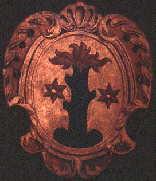 |
| Graffenried Coat-of-Arms. Medieval churches usually feature the devices of aristocratic families. |
|
|
About 10 kilometers (6 miles or so) east of Bern, Switzerland, is the town of Worb, a thriving community and center of trade. Worb was the home of the Landgrave, Christoph von Graffenried [1661–1743], founder, in 1710, of New Bern, North Carolina, USA. The Castle (Schloss) of Worb and "Neuschloss Worb" (as well as Burgisstein Castle, Chillon, and other Swiss estates formerly or presently associated with the von Graffenried family) are described and depicted in the works (1925, 1950, 1958) of American Graffenried family historian, Thomas P. de Graffenried.
A project that began in 1998 under direction of Prof. Dr. H. Schmidt of Bern University is designed to result in a detailed, multifaceted history of the community of Worb, including the areal geology, settlement beginning from Celtic and Roman times, political and social development, mortality, culture and religion, economy, the castles, and selected public figures including the "Auswanderer" known to American Graffenrieds as "Baron Christopher." The book is scheduled to appear in 2005; in the meantime, you can monitor the progress of Prof. Schmidt and his colleagues and students at http://www.hist.unibe.ch/schmidt/worb/index.htm . |
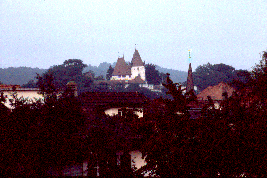 |
| My First View of the Castle at Worb (Schloss Worb) in November 1978 –MsDeG |
|
|
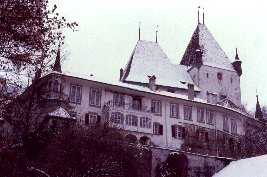 |
| A Closer View of Schloss Worb after an Overnight Dusting of Snow |
|
|
 |
| First Trip to Switzerland – MsDeG at Schloss Worb, Nov. 1978. Worb is located about 10 km. east of Bern, on the road to Lucerne. |
|
|
*WORB, SURROUNDINGS, AND SELECTED ANCESTORS*
To make shorter the long story below (in German; yes, this would annoy me too – if it were in French!): –
As a youngster I pored over my father's copy of "Uncle Tom's" 1925 'History of the de Graffenried Family,' hoping to find a picture of a Swiss "princess" that I could fancy resembled me. Of course I had developed delusions of grandeur at a much more tender age. Our first home that I can remember well – in Toronto (KS), mind you – was graced with a cupola on the second floor, above the front porch. It was "mine." The roof of the structure, with a small arched doorway and windows all around, was shaped like a "witch's hat."
I sat in my cupola (no doubt on my tuffit), surrounded by my dolls and toys, peering out into the tops of our elm trees and dreaming of castles. [This information is not actually included in the following story, but it sets the tone.]
In 1978, following a business trip to England and France, my husband treated me to a vacation in Switzerland, so I could see the castle at Worb – Schloss Worb – and the stained-glass windows in the Worb Church that honor my Graffenried forefathers and are depicted in Tom's early 20th C. de Graffenried 'History.' Tom, himself (Thomas P. de Graffenried, Esq., of New York), commissioned a window "to the memory of the noble Christoph von Graffenried, Lord of Worb, Wikartswil and Trimstein, founder of New Bern, Honorary Citizen of London, Master of Liberal Arts at Cambridge, 1661–1743." |
 |
| Our gracious hostess (at right), Frau Bernhard, at the Inn of the Lion in Worb, 1978. This lovely lady introduced us to the owners of Schloss Worb, who allowed us access to the knight's hall and the keep, and invited us into their private quarters to see the large wall hanging commemorating Baron Christopher's voyage to the New World and the book cases with the Graffenried coat-of-arms. |
|
|
Our first trip to Worb was an unforgettable adventure. Schloss Worb even has a cupola of sorts (rather grander than my doll-house, of course). The courtesy and hospitality of the Swiss people were inspiring. I have since traveled extensively with my husband and we have lived abroad. Based on my experience in Switzerland, my faith in the kindness and goodwill of the people we have since met in whatever country, some of whom have become dear friends, has never been shaken.
I might add that Frau Bernhard, the matriarch of "The Lion" Inn at Worb in 1978 – which centuries before had been part of the Graffenried estate – was the earlier counterpart of Frau Renz, our beloved "Oma" in Austria with whom we lived for a year and a half some 15 years later. I like to think that some of Baron Christopher's wanderlust rubbed off on that first magical trip to Switzerland and that I, too, am now an adventurer. I eagerly await our next trip! |
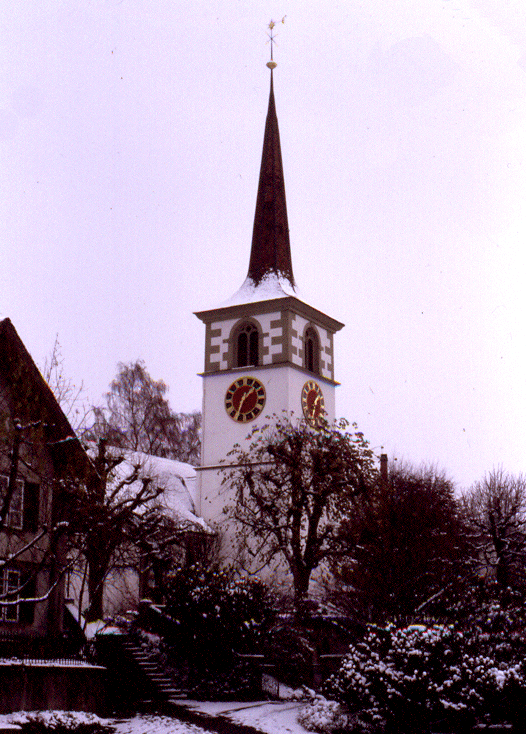 |
| Worb Church "im Schnee" |
|
|
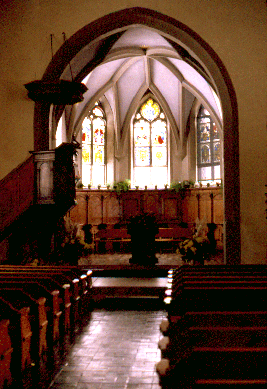 |
| Worb Church Interior |
|
|
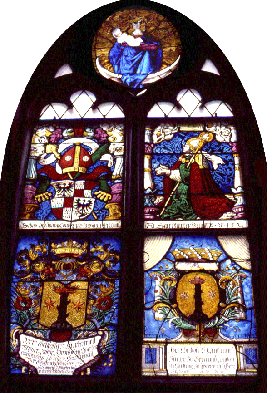 |
| One of the "Graffenried Windows" |
|
|
| Worb bei Bern – die Umgebung und ausgewählten Urahnen |
|
| Prepared in April 1986 for a college-class slide presentation; experienced in 1978 – but dreamed about since childhood! All due apologies to more advanced students of German. Corrections will be welcomed (albeit with chagrin!). –MsDeG |
Bern, eine der schönsten Städte der Schweiz, im 12. Jahrhundert gegründet, ist die Bundeshauptstadt der Schweizerische Eidgenossenschaft und die Hauptstadt des Kantons Bern. Sie befindet sich am Fluß Aare im nordwestlichen Mittelpunkt der Schweiz. Zehn Kilometer östlich von Bern, an der Straße nach Luzern, liegt Worb, eine angenehme Gemeinde mitten im aussichtsreichen Hügelland mit prächtigen, gedeihenden Bauernhöfen und ausgedehnten Wäldern.
In dem älteren Dorfteil Worb gibt es mehrere Läden, eine Apotheke, einen Schreibwarenhändler, eine Sparkasse und die Post. Gegenüber der Post ist der "Gasthof zum Löwen." Die alten Tavernen waren die gesellschaftlichen und wirtschaftlichen Mittelpunkte der Dörfer. Worb hatte schon 1375 eine Taverne. Die Taverne zu Worb ist der heutige "Gasthof Löwen." Seit über 300 Jahren ist der "Löwen" in ununterbrochenem Besitz der gleichen Familie. Früher gehörte er zu den Herrschaftsgütern. Gegenüber dem "Löwen" ist die Kirche von Worb, wohin mehrere Generationen der Familie Graffenried beigesetzt wurden.
Worb reicht tief ins Mittelalter zurück.* Das Schloß Worb, mit Blick auf das Dorf, dürfte ungefähr in den Jahren 1000–1050 entstanden sein. Es befindet sich auf einem künstlichen Hügel, der durch den Schloßgraben ringsum von seiner naturlichen Umgebung getrennt wurde. Der älteste Teil der Burg hat Mauern bis zu drei Meter Dicke. Die beiden hohen Türme, die weithin ins Land hinausschauen, enthalten Rittersaal und Schloßkapelle.
Die Herrschaft Worb war um das Jahr 1100 im Besitz des adeligen Geschlechtes der Worwo. Um 1200 soll das Schloß von Adelbert von Zähringen dem Bruder Berchtolds IV. bewohnt worden sein. Es war Berchtold V. der die Zähringerstadt Bern gründete. Die Freiherrn von Kien folgten dem Adelbert. Das Schloß Worb spielte als selbständige Rittersburg nie eine wichtige Rolle, weil die Herrschaft schon anfangs des 14. Jahrhunderts ins Berner Bürgerrecht aufgenommen wurde.
Aus den zahlreichen "Oberherren zu Worb" ragen zwei Geschlechter hervor: Adrians von Bubenberg, damals Kirchherr von Worb; Niklaus von Diesbach, der reichste Berner seiner Zeit (1434 wurde er durch einen Wappenbrief vom deutschen Kaiser in den Adelsstand erhoben); und fast über das ganze 18. Jahrhundert, die Familien von Graffenried.
|
|
| Das Dorf Grafenried, auch in the Nähe von Bern, ist der Stammsitz der Familie Graffenried. 1191 sind Uolricus und Cuno de Gravinsried zuerst erwähnt in Urkunden. Den vorhandenen schriftlichen Zeugnissen nach, wohnten Uolricus und Cuno in Oberwangen bei Gravinsried am 4. Oktober 1272. Die Familie ließ sich in Bern früher als 1350 nieder, und vorhandene öffentliche Akten zeigen Johannes von Graffenried als Mitglied der Landesregierung schon 1352. Von 1352 bis 1798 hatten 86 Graffenrieds ihres Land in solcher Eigenschaft gedient, und sind eng mit der Geschichte von Bern verbunden.
|
Nachdem der letzte Diesbach, der damalige Herr von Worb, im Jahre 1607 ohne männliche Nachkommen starb, kam das Erbe an seine zwei Töchter Maria und Ursula, Gemahlin Abrahams von Graffenried. Maria wurde kinderlos Witwe und vermachte ihren Anteil den Kindern ihrer Schwester Ursula. Christoph von Graffenried (Christoph "der Venner" genannt), der älteste Sohn Abrahams, befand sich im Jahre 1668 im Besitz von der ganzen Herrschaft. Da sein älterer Sohn Caspar früh starb, wie auch dessen beide Söhne, konnte sein Bruder Anton von Graffenried die Herrschaft an sich ziehen. Christoph, Antons Sohn (genannt "der Landgraf" und später "der Amerikaner") ist 1710 der Gründer von Neu-Bern in Nord-Carolina.
|
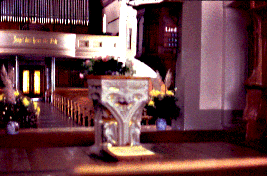 |
| Worb Church Interior |
|
| In der Kirche zu Worb, die schon in der Zähringerzeit existierte, gibt es schönen Fenster aus bemaltem Glas. Sie sind Wappenscheiben, die der Kirche gestiftet wurden um den Vorfahren zu ehren. Eine Kombination des alten Graffenriedwappens, die flammende Fackel mit zwei Sternen, mit demjenigen von Neu-Bern ehrt Christoph. Die Strahlen erinnern daran, daß Christoph auch Ritter des Ordens der goldenen Sonne war. Die Inschrift auf der Scheibe lautet:
"Zum Gedächnis des hochedlen Christoph von Graffenried, Herr von Worb, Wikartswil und Trimstein, Gründer von Neu-Bern, Ehrenbürger von London, Meister der freien Künste zu Cambridge, 1661–1743. Errichtet durch einen seiner Nachkommen in Amerika, Thomas P. von Graffenried, 1926."
Der älteste (geb. 1691) Sohn Christophs, nach seinem Vater genannt, folgte dem Vater nach Nord-Carolina und kehrte nicht mehr zurück. Im Jahre 1780, trotzt seines Protests, wurden die Schloßgüter zu Worb von der Witwe Emanuel de Graffenrieds verkauft. Christoph hat eine zahlreich Nachkommenschaft in Amerika hintergelassen, die sich bis zum heuten Tag fortgesetzt hat.
Thomas P. de Graffenried war Rechtsanwalt in Neu-York in den Vereinigten Staaten. Im Jahre 1925 nach weitgehenden Forschungen erschien sein Buch, 'Die Geschichte der Familie von Graffenried von 1191–1925'. |
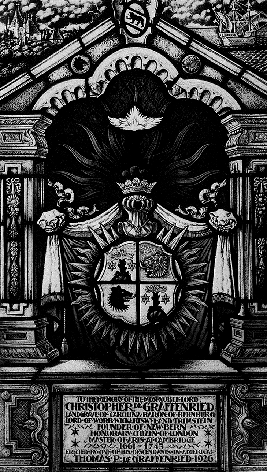 |
| 1926 Memorial to Baron Christopher in Worb Church [as reproduced in 'The de Graffenried Family Scrap Book' (1958), because I haven't been able to find my slide yet]. |
|
|
Mein Vater hat eines von diesen Büchern. Es ist dick und dunkelrot mit klein gedruckten Text. Auf dem Deckel gibt es ein eingeprägtes Wappen. Als Kind dachte ich nicht viel an das Buch. Ich sah die viele Bilder an und blätterte in den Seiten. Dann hatte ich andere Bücher zu lesen und andere wichtigere Sachen zu tun. So dachte ich. Jetzt bin ich froh daß ich die älteste Tochter bin. Mein Vater hat keinen Sohn. Eines Tages wird mir das Buch gehören.
Mein Mann neckt mich gern und nennt mich "die Baronin." Eigentlich hat er Interesse für die Genealogie meiner Familie, weil er sich schon lange für die Heraldik — die Wappenkunde — interessiert. Vor acht Jahren (1978) nachdem wir eine Geschäftsreise auf Frankreich gemacht hatten, fuhren wir nach der Schweiz um die Kirchenfenster Worb anzusehen. Voller Erwartungen kamen wir früh im Nachmittag an. Aber wir hatten mit einer solchen erfolgreichen Erfahrung nicht gerechnet.
Wir fanden nur eine einzelne Kirche, aber sie sah verhältnismäßig neu aus. Einige von den Wappenscheiben stammen aus dem 16. Jahrhundert. (Die Worberscheiben von 1521 und 1522, die der Kirche von Niklaus von Diesbach gestiftet wurde, gehören zum Besten, was die Kunst der Glasmalerei überhaupt geschaffen hat.)
Ich ging in die Apotheke und erklärte auf gebrochenes Deutsch unseren Zweck.
"Wir möchten gern die Graffenriedswappen ansehen. Sind sie in diese Kirche, wie es in dem alten Buch meines Vaters steht?"
"Ach so!" sagte der Apotheker sehr freundlich, "Sie heißen Graffenried. Dann wird die Frau Bernhard Sie kennenlernen wollen."
Frau Bernhard war einmal Gastwirtin des "Löwens", der jetzt von ihr Sohn betrieben wird. Er ist Gastwirt der 12. Generation der Familie Bernhard. Obwohl der Gasthof zur Zeit geschlossen war, wurden wir eingeladen, dort zu wohnen. Er war sehr angenehm und gemütlich. Auch hatte für uns die Frau Bernhard von den gegenwärtigen Besitzern des Schloßes eine Aufforderung zu einem Besuch bekommen. Diese erste Reise nach Worb war, ohne Zweifel, einen von den Höhepunkte meines Lebens. |
__________
*Eigentlich geht die Geschichte von Worb bis in die Römerzeit zurück.
|
|
|
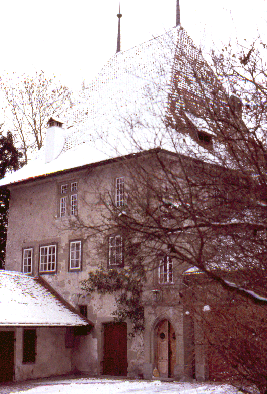 |
| Schloss Worb Entry (left) and View of Interior Courtyard |
|
|
|
|
 |
| Bookcase with Graffenried Wappen; Another View of Schloss Worb; Village of Worb Photographed from Castle Keep. |
|
|
|
|
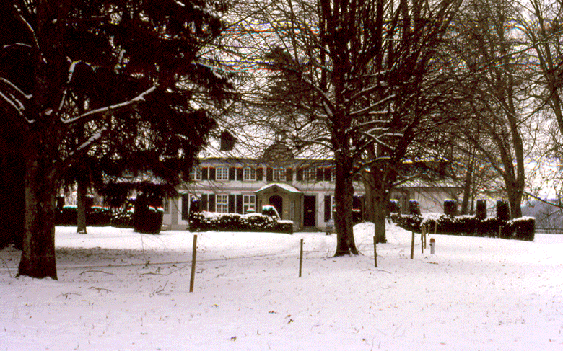 |
| Neuschloss Worb im Schnee, 1978 |
|
|
 |
| Neuschloss Worb, Switzerland, Prior to 1989. The complete history of the Neuschloss including the landscaping phase [1988–1989] is given in M.F. Rubli's large-format book, with marvelous pictures, paintings, drawings and architectural renderings (Benteli Verlag, Bern, 1992). |
|
|
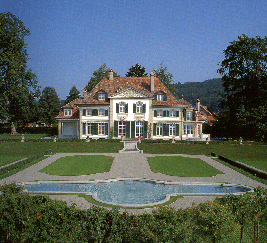 |
| Restoration of Newschloss Worb [1990–1992] |
|
|
| I was an "English major" throughout my rather extended college career. Poetry was de rigueur. My honors paper dealt with a recurring theme in the novels of my favorite author, Henry James. Hence, I could not properly experience Switzerland without visiting Vevey and Schloss Chillon. Fortunately, my husband recognized this fact and was willing to indulge me. |
 |
| 12th C. Schloss Chillon on Genfer See (Lake Geneva) in Mid-1980s |
|
|
A SONNET ON CHILLON
George Gordon, Lord Byron (1788–1824)
…Chillon! thy prison is a holy place,
And thy sad floor an altar - for t'was trod,
Until his very steps have left a trace
Worn, as if thy cold pavement were a sod,
By Bonnivard! May none those marks efface!
For they appeal from tyranny to God. |
 |
| Kerker (Dungeon) of Schloss Chillon |
|
|
In 1816 Byron, accompanied by Shelley, visited Chillon and was inspired by marks in the stone floor of the dungeon – attributed to the pacing of François de Bonnivard during his imprisonment from 1532-1536 – to write a sonnet. Byron later composed "The Prisoner of Chillon."
In 1876 Henry James penned the first of his works to meet with critical and popular acclaim, the novella, "Daisy Miller." Daisy's downfall was foreshadowed by her nonchalant determination to visit the medieval Castle of Chillon alone with Frederick Winterbourne, an expatriate fellow-American who recognizes that Daisy's innocent flirting is outrageous by European standards. Sadly, although he is sympathetic, Frederick's acquired sensibilities will not allow him to intervene and Daisy's naive, youthful exuberance is ultimately self-destructive. |
 |
| Prof. John C. Davis und Frau Jo Anne DeGraffenreid – Muri bei Bern, Switzerland, 1992. Photo by Helmuth de Graffenried. |
|
|
|